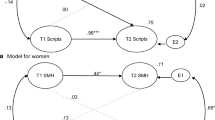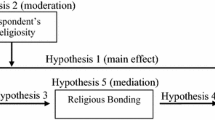Abstract
The purpose of this study was to evaluate the mediation effect of sexting, and taking sexually suggestive photos on religiosity and hooking-up with three separate sexual outcomes. A web-based survey examined the relationship between religiosity and the three hooking-up outcomes among students reporting sexting or taking a sexually suggestive photo in the last 30 days (n = 231). Sexting, as well as taking sexually suggestive photos mediated the relationship between religiosity and hooking-up among females. Sexting may be initiated by females as a way to engage in a nonphysical sexual interaction, which ultimately predisposes them to a physical sexual outcome.
Similar content being viewed by others
References
Albury, K., & Crawford, K. (2012). Sexting, consent and young people’s ethics: Beyond Megan’s Story. Continuum,26(3), 463–473.
Bailey, B. L. (1989). From front porch to back seat: Courtship in twentieth-century America. Baltimore, MD: Johns Hopkins University Press.
Baron, R. M., & Kenny, D. A. (1986). The moderator–mediator variable distinction in social psychological research: Conceptual, strategic, and statistical considerations. Journal of Personality and Social Psychology,51(6), 1173–1182.
Beckwith, H. D., & Morrow, J. A. (2005). Sexual attitudes of college students: The impact of religiosity and spirituality. College Student Journal,39(2), 357–366.
Benotsch, E. G., Snipes, D. J., Martin, A. M., & Bull, S. S. (2013). Sexting, substance use, and sexual risk behavior in young adults. Journal of Adolescent Health,52(3), 307–313.
Crimmins, D. M., & Seigfried-Spellar, K. C. (2014). Peer attachment, sexual experiences, and risky online behaviors as predictors of sexting behaviors among undergraduate students. Computers in Human Behavior,32, 268–275.
Davey-Rothwell, M. A., Tobin, K., Yang, C., Sun, C. J., & Latkin, C. A. (2011). Results of a randomized controlled trial of a peer mentor HIV/STI prevention intervention for women over an 18 month follow-up. AIDS and Behavior,15(8), 1654–1663.
Dir, A. L., Coskunpinar, A., Steiner, J. L., & Cyders, M. A. (2013). Understanding differences in sexting behaviors across gender, relationship status, and sexual identity, and the role of expectancies in sexting. Cyberpsychology, Behavior, and Social Networking,16(8), 568–574.
Döring, N. M. (2009). The Internet’s impact on sexuality: A critical review of 15 years of research. Computers in Human Behavior,25(5), 1089–1101.
Emons, W. H., Sijtsma, K., & Meijer, R. R. (2007). On the consistency of individual classification using short scales. Psychological Methods,12(1), 105–120.
Felmlee, D., Sweet, E., & Sinclair, H. C. (2012). Gender rules: Same-and cross-gender friendships norms. Sex Roles,66(7–8), 518–529.
Glenn, N., & Marquardt, E. (2001). Hooking up, hanging out, and hoping for Mr. Right. In An Institute for American Values Report to the Independent Women’s Forum.
Glock, C. Y. (1962). On the study of religious commitment. Religious Education: The official journal of the Religious Education Association, 57(sup 4), 98-110.
Gordon-Messer, D., Bauermeister, J. A., Grodzinski, A., & Zimmerman, M. (2013). Sexting among young adults. Journal of Adolescent Health,52(3), 301–306.
Hollander, D. (2005). Many young teenagers consider oral sex more acceptable and less risky than vaginal intercourse. Perspectives on Sexual and Reproductive health,37(3), 155–157.
Houck, C. D., Barker, D., Rizzo, C., Hancock, E., Norton, A., & Brown, L. K. (2014). Sexting and sexual behavior in at-risk adolescents. Pediatrics,133(2), e276–e282.
Hulin, C., Cudeck, R., Metemeyer, R., Dillion, W. R., McDonald, R., & Bearden, W. (2001). Can a reliability coefficient be too high? Journal of Consumer Psychology,10, 55–69.
Jackson, P. B., Kleiner, S., Geist, C., & Cebulko, K. (2011). Conventions of courtship: Gender and race differences in the significance of dating rituals. Journal of Family Issues,32(5), 629–652.
Jozkowski, K. N., Peterson, Z. D., Sanders, S. A., Dennis, B., & Reece, M. (2014). Gender differences in heterosexual college students’ conceptualizations and indicators of sexual consent: Implications for contemporary sexual assault prevention education. The Journal of Sex Research,51(8), 904–916.
Lambert, T. A., Kahn, A. S., & Apple, K. J. (2003). Pluralistic ignorance and hooking up. Journal of Sex Research,40(2), 129–133.
Lenhart, A. (2009). Teens and sexting. Retrieved from http://www.pewinternet.org/files/old-media/Files/Reports/2009/PIP_Teens_and_Sexting.pdf.
O’Neal Nagel, P., Cummings, T., Hansen, C. H., & Ott, M. A. (2013). Predictors of sexting in a university population. Journal of Adolescent Health, Poster Abstract, 52(2 Supplement 1), S87.
Owen, J. J., Rhoades, G. K., Stanley, S. M., & Fincham, F. D. (2010). “Hooking up” among college students: Demographic and psychosocial correlates. Archives of Sexual Behavior,39(3), 653–663.
Paul, E. L., & Hayes, K. A. (2002). The casualties of casual’sex: A qualitative exploration of the phenomenology of college students’ hookups. Journal of Social and Personal Relationships,19(5), 639–661.
Penhollow, T., Young, M., & Bailey, W. (2007). Relationship between religiosity and “hooking up” behavior. American Journal of Health Education,38(6), 338–345.
Penhollow, T., Young, M., & Denny, G. (2005). The impact of religiosity on the sexual behaviors of college students. Journal of Health Education,36(2), 75–85.
Preacher, K. J., & Hayes, A. F. (2004). SPSS and SAS procedures for estimating indirect effects in simple mediation models. Behavior Research Methods, Instruments, & Computers,36(4), 717–731.
Reid, J. A., Elliott, S., & Webber, G. R. (2011). Casual hookups to formal dates refining the boundaries of the sexual double standard. Gender & Society,25(5), 545–568.
Rice, E., Rhoades, H., Winetrobe, H., Sanchez, M., Montoya, J., Plant, A., et al. (2012). Sexually explicit cell phone messaging associated with sexual risk among adolescents. Pediatrics,130(4), 667–673.
Ross, M. W. (2005). Typing, doing, and being: Sexuality and the Internet. Journal of Sex Research,42(4), 342–352.
Samimi, P., & Alderson, K. G. (2014). Sexting among undergraduate students. Computers in Human Behavior,31, 230–241.
Schmitt, D. P., & Fuller, R. C. (2015). On the varieties of sexual experience: Cross-cultural links between religiosity and human mating strategies. Psychology of Religion and Spirituality,7(4), 314.
Substance Abuse and Mental Health Services Administration. (2008). National survey on drug use and health, 2007 public use codebook. Ann Arbor, MI.
Temple, J. R., Le, V. D., van den Berg, P., Ling, Y., Paul, J. A., & Temple, B. W. (2014). Brief report: Teen sexting and psychosocial health. Journal of Adolescence,37(1), 33–36.
Temple, J. R., Paul, J. A., van den Berg, P., Le, V. D., McElhany, A., & Temple, B. W. (2012). Teen sexting and its association with sexual behaviors. Archives of Pediatrics and Adolescent Medicine,166(9), 828–833.
Vazsonyi, A. T., & Jenkins, D. D. (2010). Religiosity, self-control, and virginity status in college students from the “Bible Belt”: A research note. Journal for the Scientific Study of Religion,49(3), 561–568.
Walker, S., Sanci, L., & Temple-Smith, M. (2013). Sexting: Young women’s and men’s views on its nature and origins. Journal of Adolescent Health,52(6), 697–701.
Weisskirch, R. S., & Delevi, R. (2011). “Sexting” and adult romantic attachment. Computers in Human Behavior,27(5), 1697–1701.
Author information
Authors and Affiliations
Corresponding author
Rights and permissions
About this article
Cite this article
Hall, M., Williams, R.D., Ford, M.A. et al. Hooking-Up, Religiosity, and Sexting Among College Students. J Relig Health 59, 484–496 (2020). https://doi.org/10.1007/s10943-016-0291-y
Published:
Issue Date:
DOI: https://doi.org/10.1007/s10943-016-0291-y




